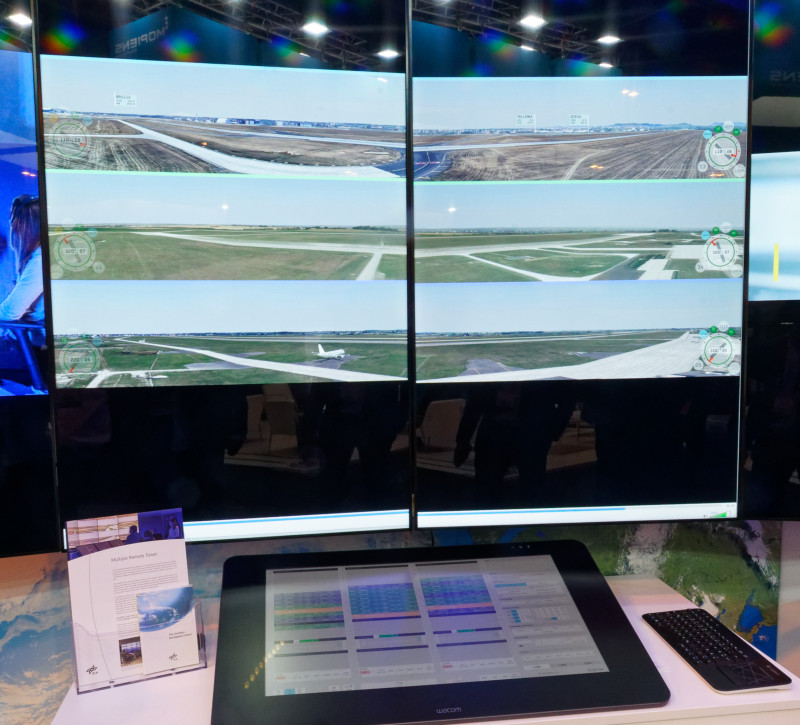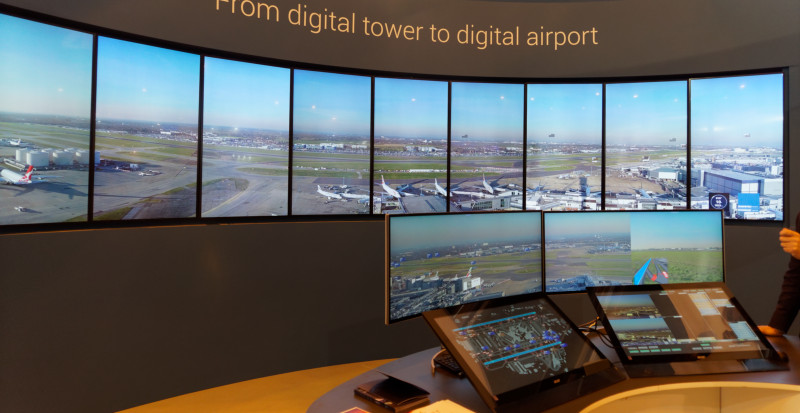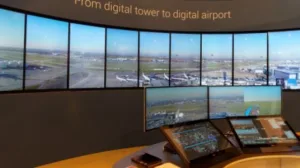Last week, I was in Madrid for the WorldATM Congress (Air Traffic Management) and I saw a replica of what might be the highest resolution augmented reality system in the world (unless you know different – in which case, contact me!).

The display was a replica of a system that has been built at London’s Heathrow Airport that is acting as a ‘virtual control tower’ – an interesting development in aviation and air traffic control that I have been following for a while.
The idea is that you replace a traditional control tower, where controllers look out over the runway through big picture windows. To do that, you mount a number of high resolution cameras so that they have the full field of view that you would get from the tower (or more) and ensure that you have the same resolution as though you were looking out of a glass window. Of course, that generates a lot of video data, but that can be sent over fibre to a control room where the image is displayed.
There are a number of advantages to this.
- Lightly used airfields can operate for much longer hours or at lower cost if the traffic management is operated remotely. This is being done in Norway so that airfields in the cold north can operate more efficiently.
- Shadow control rooms can be set up to deal with emergency conditions such as a terrorist attack or other physical damage to the traditional tower.
- The image can be overlaid with additional information such as aircraft IDs, or tracking of ground vehicle movements. Some have also added infrared cameras to allow heat information to be seen (indicating, for example, if an engine is operating). However, at the WorldATM event we heard that the infrared cameras are lower resolution than the visual ones, so it may not be so useful.
- More than one runway may be controlled by a single operator. At the WorldATM event, the Deutsches Zentrum für Luft und Raumfahrt in Germany showed us how it is testing the idea of having a single controller for three separate runways at different locations. There will be a project to shadow three airfields in Hungary in the next few months to check if the configuration can be operated safely.
 Test of three control rooms with a single operator, Image:Meko
Test of three control rooms with a single operator, Image:Meko
Heathrow Has Another Challenge
London’s Heathrow Airport has a different problem. The UK government has decided to expand the airport to add a third runway. Unfortunately, the runway will be divided from the current runways because of a lot of buildings and will be a long way from the existing control tower. In the past, this would have meant building a new tower between the existing and new runways – at a potential cost of €50 million to €60 million.
As an alternative, the airport authorities have set up a test virtual control tower with Searidge of Canada to evaluate whether the technology can be used and a facsimile of the tower was shown in Madrid. One difference was that the set up at the show used standard FullHD displays, while the real installation uses narrow bezel Samsung UltraHD panels. Nine UltraHD displays means around 72 million pixels – which is why we think this could be the highest resolution AR system in the world!
If the current test is successful, the new third runway (if it is built, as it is being challenged in the courts) might use a virtual control tower in the existing building which would save a lot of money. We have also heard in the past that the airport was looking at this possible development to have a back up if there was an event that caused problems with the main tower. (BR)
 This was the mock up of the Heathrow Virtual Tower. Image:Meko
This was the mock up of the Heathrow Virtual Tower. Image:Meko

